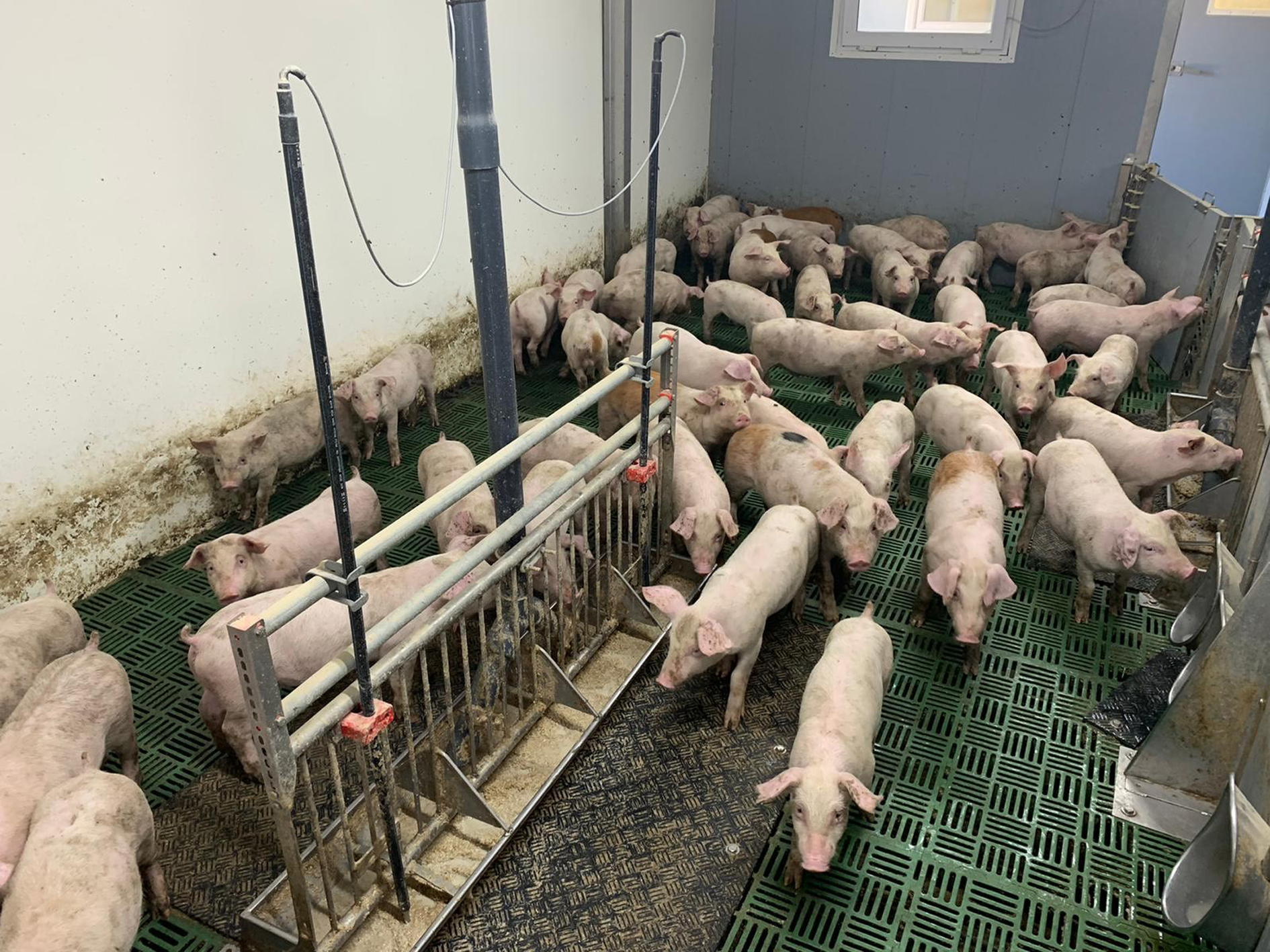Hybrid rye makes its mark for farm to fork pig operation
Hybrid rye gets the name of being one of the most productive, easy to grow and sustainable crops on the market, with growing demand being driven by a variety of end-uses including significant benefits resulting from its inclusion in pig rations, as one large Scottish farming operation is finding out.
Using hybrid rye has brought substantial benefits to both arable rotations and the farrow-to-finish unit at A Marshall and Sons’ Slighouses Farm, Duns, Berwickshire.
“There are many advantages to rye and so far, no negatives, so if farmers have any concerns about growing the crop or using it, they really shouldn’t,” said arable grower and pig producer Adam Marshall jnr, who drilled his first rye crop in autumn, 2018.
“Rye has benefitted the arable side of our business, while including it in home-milled-and-mixed rations has substantially reduced our feed costs, improved herd health and increased pig performance.”
His father, Adam snr and brother Charlie, consist of the fourth and fifth generations of the family to farm Slighouses. In addition to the 85ha (213 acres) they own there, the family contract farms another 200ha (500 acres) in the area, participating in a machinery sharing group with two neighbours to cultivate, drill and combine up to 800ha (2000) acres.
The pig enterprise was established by Adam senior’s father and uncle in 1954 and today uses all its own grain, milled and fed to the pigs, making the enterprise self-sufficient in feed. This not only allows 100% traceability, but also ensured the meat produced is of consistent, excellent quality.
“Pigs are the focus of our business and herd performance was already at a high level when my father and I began researching the use of rye in pig rations after hearing good things about it being fed to pigs on the continent and discussing it with our agronomist, Andrew Wallace, of Agrii," said Adam jnr.
“We felt this was the way forward and subsequently discussed it with our nutritionist, Kevin Stickney, from Harbro, and Will French, one of the company’s pig specialists, who helped us to include rye in the rations. Not wanting to do anything that might compromise what we had worked so hard to build up I had some reservations, but after feeding it on a small scale in the form of bakery waste for eight months after drilling our first crop of rye two years ago our cost fell by £9 per tonne and the pigs benefitted.
“Growing rye on the farm came about because we wanted to introduce another arable crop as the performance of second wheats can be very variable on lighter land and we wanted out of malting barley because the costs and risks involved were increasing.”
John Burgess, maize and hybrid rye product manager at KWS, supplied the business with information and feeding data on rye, so for the 2018/19 season it was decided 22 ha (55 acres) would be grown, which yielded 9.75 tonnes/ha (3.9 t/acre), Adam recalled.
“We were pleased with that because the field included several bare patches where we did not drill the seed quite deep enough and the birds took it. We learned the hard way that sowing depth is critical – if it goes in too deep it takes too long to emerge, too shallow and it gets eaten.
“We are hoping for better results this season because of improved weather and the fact that we made a much better job of establishment, using a Simba SL disc/tine cultivator, followed by one pass over heavy ground with a Simba CultiPress before sowing with an 8m Vaderstad Spirit.
“We currently have 44/ha (110 acres) of KWS Daniello in the ground, which was drilled 1-2cm deep, at 200-250 seeds/m2 and has looked good throughout the season.”
Hybrid rye has quickly become part of the rotation, which also includes winter wheat, oilseed rape, spring malting barley and vining peas, Adam jnr pointed out. But it's proving so popular that some is being bought in. “One of our neighbours, John Swan of WB and AG, Swan Blackhouse, Reston – who is part of our contract farming operation – is also growing rye, which we purchase to use in our pig rations.
“Rye has also been a positive option for him on fields which would otherwise grow second wheat. In our experience, it is easier to grow than winter barley, with less financial risk. Being less susceptible to most leaf diseases than other cereals, it also requires far fewer agrochemical inputs.
“It also needs only 120 kg/ha of nitrogen, which is about 25% less than for winter barley, so there are significant savings. Our variable costs are £156.94 per ha.”
On September 20, the Marshalls’ crop received 2 l/ha of Defy (Syngenta) and 2 l/ha of Tribal (Adama) herbicides. In the spring, March 30, it got 0.25 l/ha of Tubosan fungicide (Belchim), 0.15 l/ha of Cleancrop Alatrin Evo PGR (Syngenta) and trace elements in the form of 2.5 l/ha of Master Manganese Plus (Adama).
A week after that, on April 8, a further 0.15 l/ha of Cleancrop Alatrin Evo PGR went on with 2 l/ha of 3C Chlormequat 750 (BASF), 0.5 l/ha of Kestrel fungicide (Bayer), 0.25 l/ha of Avocet herbicide (Corteva) and 3 l/ha of Master Manganese+TE trace elements, tank mixed with 0.25 l/ha of Zeal adjuvant (Interagro).
At the end of the first week in May, 0.5l/ha of Canopy (Bayer) growth regulator was applied, then on May 21 it received a further 2 l/ha of Master Magnesium +TE, 0.5 l/ha of Prosaro (Bayer) fungicide, 0.5 l/ha of Canopy and 0.1 l/ha of adjuvant.
“Hybrid rye has performed so well that we are considering eliminating winter barley from the rotation,” Adam explained. “The crop is taller and produces 50% more straw, which reduces the speed of our New Holland 8.90 combine, but it provides good bedding and burns well in our 450 kWh biomass boiler which heats our new piggeries, various properties on the farm and the Opico grain dryer.”
Rye has a unique fibre profile which can significantly improve gut health, which in turn improves performance, pointed out Harbro’s Will French.
“Working in partnership with our customers from Aberdeenshire to Cornwall, we are formulating bespoke rations that include rye in both dry and wet feed. From the results we have seen, it performs well across a range of breeds and can be used in all diets.”
John Burgess confirmed that feeding more rye provided pig producers with significant production, animal health, environmental and economic advantages, so the acreage grown to service this demand can only grow in the future. “Rye is an established component of pig rations in countries such as Denmark, Germany, Russia, Poland and Spain," he said.
The requirement for water is 25% less than wheat or barley, making it ideal an ideal crop for light land or in drought-prone areas.
“The UK has the potential to easily and quickly increase the area of hybrid rye grown by 10%, which could have a profound effect on the UK pig industry and the make-up of the country’s arable area. In terms of pig production, the biggest benefits lie in improved feed intake, environmental enrichment for animals and digestive benefits.
"Rye is high in water absorbent dietary fibre which requires more active chewing and increases the production of saliva, reducing the overall acidity of material entering the stomach. At around 8-9%, its protein content is also significantly less than wheat and barley, which reduces protein wastage and slurry production."
There are also agronomic and economic benefits, too. “Yields have increased by 20% in recent years, with modern varieties such as KWS Serafino, KWS Tayo and KWS Edmondo capable of producing consistent yields up to 11t/ha and easily outperforming wheat and barley in the second or third cereal slot. Its rapid development helps to crowd out weeds, while the requirement for water is 25% less than wheat or barley, making it ideal an ideal crop for light land or in drought-prone areas.”
All rye grown by the Marshalls is used to replace some of the wheat and barley in the rations, which are produced using an 8t/h mobile mill-mixer. This approach has significantly reduced the cost of rationing, which at today’s prices for rye average £137 per tonne, £18/t (13%) less than before.
The finisher ration comprises 36% rye, 32% winter barley, 18% soya and 10% wheat, the one for lactating sows 28% barley, 22% rye, 19% soya, 12.5% waste porridge oats and 10% wheat, the balance being made up of concentrates.
Their Schauer multi-phase spot mix feeding system used was the first in the UK when installed two years ago and records all data on a per-pen basis, so any differences in pig performance are immediately apparent and accurately recorded.
Average daily live weight gain from weaning to finishing is 860g, Adam jnr said. “Since we began growing hybrid rye in 2018, we have gradually increased the inclusion rate in both the lactating sow and finisher rations, and will keep doing so because of the positive effects.
“Despite reducing feed costs considerably, intake has been maintained and there have been no negative effects on pig health or behaviour, although our pigs are inherently placid and easy to work with.
“Having previously operated a 100-sow unit and bred our own gilts, we opened the new unit in 2012 and began using DanBred genetics across our farrow-to-finish operations. We chose them because we felt that they were the market-leading pig and still feel that way today.
“We currently have 230 DanBred sows, which have averaged 31-33.5 pigs per sow per year since starting with DanBred genetics, together with 1250 weaners and 1250 finishers which average 84kg after 21weeks. Our bacon pigs have an average probe reading of 11.2mm and pork pigs that go to our hog roast operation average 12mm at 60kg dead, so we have room for manoeuvre in terms of pushing the pigs harder without worrying about weights and probe measurements.”
Key attributes looked for in a pig carcase for off-farm sale and for the hog roast business are uniformity, high marble content and 10-12mm of fat, but no more as this gives the meat a fantastic look and crackling content, Adam explained. “The eating quality of our pigs is outstanding and a real asset to our retail business, Oink, which takes 40% of our finished pig production on an annual basis and all of it from July to September.”
Taking the farm to the city
In 2000, Adam Marshall SNR and fellow local farmer, Sandy Pate, started a meat retailing and hog roasting business, developing it since.
“We had the simple idea of bringing our quality natural product from the farm directly to customers in Edinburgh,” Adam snr said. “We are passionate about good honest food and wanted to introduce a different food concept to the city, with our fresh and delicious Scottish hog roast rolls.
“My family used to operate 20 butchery shops which were sold some years back, so in 2001 Sandy and I decided to bring our freshly carved hog roasts direct to consumers at Edinburgh Farmers Market and have never looked back."
When they decided to open its first shop in Edinburgh, that’s when our ‘Oink of Edinburgh’ brand was born. The name sets it apart and has certainly attracted a lot of attention. This was launched in Victoria Street in summer 2008 and since then has been serving hungry workers, locals, students, festival goers, shoppers and tourists seven days a week, Adam snr added.
“We opened our second shop in summer 2013 in the Canongate area of the historic Royal Mile and in 2017 added third shop on Hanover Street in the heart of the city. We also operate our successful Oink mobile catering service, which specialises in hog and lamb roasts for groups of 25 to 250 people, including weddings, birthdays and corporate events.”




